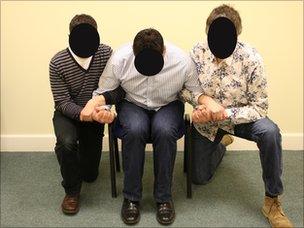Jimmy Mubenga: A death waiting to happen?
- Published
- comments

Academics found this hold was potentially fatal - picture shows volunteers in the research
The jury at the inquest of a man who died on a plane while he was being deported from the UK in October 2010 has returned a verdict of unlawful killing. The case of Jimmy Mubenga raises questions about how force can be used in immigration removals.
Jimmy Mubenga was being deported to Angola after serving a two-year prison sentence for assault occasioning actual bodily harm. He had appealed against deportation because he had been settled in the UK and his wife and children would be left behind.
There was a struggle between Mr Mubenga and three G4S security guards who had been employed by the then UK Border Agency to manage his departure from the country.
They restrained him, placed him in handcuffs and forced him into his seat. What happened next was the crucial question at the inquest.
The coroner, Karon Monaghan QC, told the jury there was no medical doubt that Mr Mubenga had died from "cardio-respiratory collapse" - but the question was how.
Mr Mubenga was escorted on to the flight by three guards from G4S - Terry Hughes, Colin Kayler and Stuart Tribelnig, the senior member of the team. They had all been taught how to use handcuffs and force.
Mr Tribelnig told the inquest that Mr Mubenga went to the toilet and then came out and lunged at him.
The guards said that as Mr Mubenga continued to fight against them, kicking out, he forced his own head and torso downwards as part of his resistance.
But Rosa Da Silva, a passenger sitting nearby, was among many who gave a different account in a statement that was read to the inquest.
"I could not see the black man's face because the security men had pushed his head forward but the man was screaming out," she said. "The security men was standing over him and trying to push him down or keep him down.
"The black man was screaming out. It was muffled but I could hear him say, 'Help, help, I can't breathe. You are killing me.'"
The commotion went on for about 15 minutes before Mr Mubenga went quiet. Mrs Da Silva thought that the security men had calmed down the detainee. Minutes later, the plane returned to the terminal and paramedics rushed on board.
The three security guards were arrested following the death. But almost two years later the Crown Prosecution Service said that there was insufficient evidence to charge anyone with gross negligence manslaughter.
'Carpet karaoke'

Jimmy Mubenga: Unlawfully killed
At the inquest, the guards said they had been told in training that someone could die from "positional asphyxia" if their head and torso were forced down to their knees while they were seated.
Ian Duckers, the G4S driver who took the team to the plane - but did not board the plane and witness the struggle - said that he had been warned in his training that "carpet karaoke", forcing someone down so their screams cannot be heard by other passengers, was not allowed.
But was this a death waiting to happen? Have the authorities failed to properly assess the use of force on immigration removal flights?
Campaigners say that, two years before Mr Mubenga died, they warned the UK Border Agency of the dangerous use of force during immigration removals.
Medical Justice, a charity that provides clinicians to independently examine immigration detainees, looked at 300 cases of people facing immigration removal.
It found in a report , externalthat 42 people of them had their heads forced downwards by security officers in a way that made it difficult for them to breathe.
Dr Naomi Hartree of the charity says that to this day expert concerns have not been addressed because there is no proper guidance on which restraints to use in confined spaces such as planes.
"What we have seen so far is that even after our own 2008 report these kinds of problems are still going on.
"People are continuing to say that their head is forced downwards to their knees. This is not something in the past, it is something that is continuing to happen.
"This is another death waiting to happen."
Nine months after Mr Mubenga's death, experts from Coventry University produced a report that underlined that concern, external.
They published the results of a detailed experiment in which 40 volunteers were restrained in the controversial seated position.
The volunteers experienced breathing problems and some became alarmed and distressed. Those with larger waists suffered the worst lost of oxygen. The scientists concluded that the position, coupled with prolonged restraint, could be fatal.
The guidance for immigration removal teams is the Use of Force Training Manual,, external developed for use in prisons.
The manual includes a clear warning about the risks of positional asphyxia - but a great deal of the detail on special restraints has been redacted from the public version of the document.
New guidance
The cross-party Home Affairs Committee also raised its own concerns in a report, saying that it was "not persuaded that head-down restraint positions are never used, even though they are not authorised".
This inquest verdict is extremely serious. The Crown Prosecution Service has already said it will review its decision not to prosecute anyone over the death.
But it will renew calls for the Home Office to fully review how deportations are managed. Anecdotal and ad hoc reports of injuries are now backed up by the full force of an inquest jury declaring that someone was unlawfully killed.
Legal campaigner group Liberty went to court to try to force the publication of the redacted parts of the Use of Force Manual. It argued that nobody could know if restraint techniques for removals were safe if nobody knew what they were.
The Home Office won the court battle after arguing that publicising the techniques could help people to avoid restraint. In court it stressed that private security guards who are employed to enforce removals know about the risks.
Well since then, the Home Office has begun to look again at how deportations can be enforced.
It has asked prison service officials to come up with "bespoke training" for immigration removals. The Home Office maintains that the techniques in the existing manual are safe, yet the bespoke package will include specific guidance on how to control someone once on board an aircraft. The results will not be known for many, many months.
- Published27 July 2011